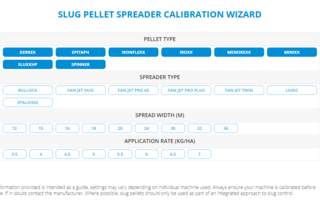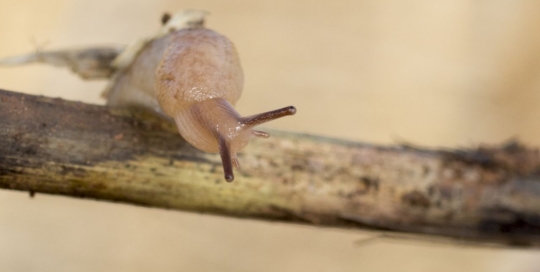SLUG FORCE
We’ve been developing and refining our ferric phosphate pellets for over 10 years, and in that time we’ve learnt an awful lot about slugs. The Slug Force hub comprises all you need to know for effective integrated slug management.
Watch the video to see why Sluxx HP’s unique formulation can offer effective slug control, whatever the weather.
The UK climate is particularly favourable for the breeding and multiplication of slugs.
There are 46 species in the UK but there are three key arable and potato pests:
• Grey Field slug (Deroceras reticulatum)
• Round back slugs (Arion spp.)
• Keeled slugs (Milax / Tandonia spp.)
Slugs within any population have variable lifecycles. Typically anywhere between 2 and 4 cycles per year. Slugs from the same batch of eggs may also grow at very different rates, some remaining very small whilst others reaching full size very quickly. It is believed that this is a survival strategy based on food supply and environmental conditions. Grey field slugs have a maximum life span of 9-12 months and are the most important slug pest in OSR and cereals.

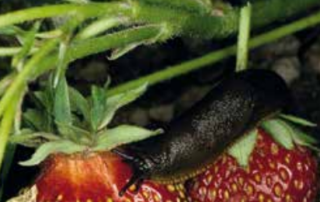
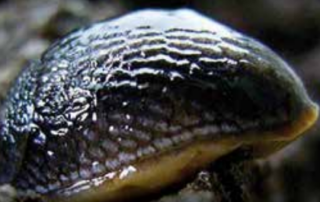
Key crop impact
Cereals – Slugs will cause seed hollowing and an individual slug can kill up to 50 seeds in the first week following drilling. Smaller slugs are more damaging and will actively feed in the top 2 cm of soil. Additional damage on shoots and leaves can occur and cereals are vulnerable until GS21.
OSR – This crop is very susceptible to damage. As the seedling develops the growing point is exposed above ground and is therefore at risk of damage. The crop is most at risk until the four leaf stage so early protection is critical.
Potatoes – The critical period for damage is early tuber bulking when slugs will enter the tuber and cause significant cavities. Be aware there are varietal differences in susceptibility to slug damage. On susceptible crops ensure a suitable durable pellet is applied during the risk period and critically before canopy closure to ensure some forward protection is offered.
ATTRACTANTS?
Slugs are random feeders – they literally stumble across their food source during periods of activity. There is no evidence that they are attracted at a distance to a specific food source.
Once the slug encounters potential food it uses chemical sensors to establish if it is appropriate and will then test the food before feeding. Attractants added to slug pellets have no real benefit but the inherent palatability of the pellet is critical to ensure the slug consumes a lethal dose.
Activity
Slugs are most active at night and will feed until full, rest until the food is digested before commencing further feeding. As night length increases during the autumn and early winter then the number of feeding cycles increases.
Slugs are most active when
- Average night time temperature is above 5⁰C
- Soil surface conditions are moist. Moisture levels in the top 5cm of soil is critical to slug activity
TIP OF THE ICEBERG
The slugs causing visible damage are just a small proportion of the actual population. The bulk of the population remains in the soil profile out of sight, it is impossible to completely eradicate slugs.
Slugs do have natural predators with the most important being ground beetles which will prey on both the slugs and their eggs. Parasitic nematodes are also found in most soils. They carry bacteria which are toxic to slugs. Slugs are also very susceptible to changes in environmental conditions, especially anything which impacts the soil moisture conditions in the top 5cm.
What risk factors are important?
Moisture and temperature are the two most influential factors. Cool, wet conditions are favoured by slugs in order to thrive. Hence mild and wet spring/autumn conditions provide ideal conditions. Even in a dry season slugs can quickly repopulate and thrive at the first arrival of rain.
Crop type – previous cropping and cover crops can all have an effect on slug populations
Soil type and drainage with water retaining soils like clays and silts, and poorly draining soils providing higher moisture levels.
Cultivation method has an effect with direct drilling, delayed drilling dates, little soil disturbance (no till) all providing good conditions for slug populations.
Crop residues, organic matter and weeds will provide cover and protection for slugs.
Nearby hedges, wasteland and ditches are refuge areas for slugs to migrate from into cropped areas.
Understanding slug pressure on an individual farm basis is essential and taking an integrated approach to slug control will prove to be the most efficacious, far more reliable than just using slug pellets alone.
There are several critical considerations for any successful integrated slug management programme.


Impact of Crop Rotation
Slug damage is much greater following leafy crops such as OSR. The leafy structure creates moist soil conditions and can leave significant crop residues on the surface post-harvest, creating an ideal habitat for slugs in terms of food and shelter.
Do avoid planting very susceptible crops (salads and leafy vegetables) after OSR.
Late drilled cereals can be at greater risk as it often takes longer for the crop to grow out of the susceptible growth stage.
Cultivations
Production of firm seedbeds makes it more difficult for slugs to move, and will also help crops grow quickly, minimising the critical period of risk.
Small grey field slugs are responsible for much of the seed hollowing in cereals and they typically feed in the top 2 cm of soil. If the seed bed is cloddy and loose, growers are advised to drill cereal seed deeper than normal to reduce seed hollowing.
Some growers are now adopting the practice of rolling newly drilled crops at night hoping to kill slugs on the surface.
Key aims of cultivation
- Distribute and mix in straw and crop debris
- Reduce clods
- Reduce cavities
Impact on slugs
- Direct mechanical damage which can significantly reduce populations in the worked soil
- Exposure to desiccation
- Exposure to natural slug predators


Monitor Slug Activity
When using slug pellets it is important to apply the slug pellet early to minimise damage.
Application needs to be timed to coincide with favourable weather conditions, producing a moist surface soil layer and when slug numbers are confirmed.
Growers are advised to utilize slug traps to monitor populations (details on slug trapping can be found in the section Tools).
The Sluxx HP pellet contains ferric phosphate. It has a different effect on slugs when compared to metaldehyde. Growers will see that slug pellets have been eaten but will not see many dead slugs on the surface.
When slugs eat a Sluxx HP pellet they quickly stop feeding and retreat underground to try and recover. They do not recover and will die underground.
Growers are advised to monitor crop damage as an indicator of slug activity along with remaining numbers of slug pellets. In high pressure situations it may be necessary to apply more than one application. Sluxx HP has a label which allows up to 4 applications per crop.

Sluxx HP is the culmination of 10 years field experience and continuous product development. Growers and Agronomists have confidence in its performance and have made it the bestselling ferric phosphate pellet in the UK market.
The Sluxx HP formulation has a number of significant benefits which differentiates it from other pellets in the market, therefore it carries the Ferric Field Technology quality mark.
What does this mean for you?
Slugs are random feeders. They literally stumble across their food source during their periods of activity. There is no evidence to suggest that they are attracted at a distance to a food source. Once the slug encounters potential food it uses chemical sensors to establish if it is appropriate and will then test the food before feeding.
Attractants added to slug pellets have no real benefit, but the inherent palatability of the pellet is critical to ensure the slug consumes a lethal dose. SluxxHP is made using processed durum wheat flour which makes it very palatable to slugs.
As you can see from the photographs below Sluxx HP pellets have a very uniform size and minimal dust content. This ensures good spread-ability up to 36m and gives a consistent number of baiting points.

Durability
Sluxx HP has a patented formulation which includes a food industry preservative to prevent moudling and ensure the active ingredients remains available and active even during wet weather conditions.
This is important as it enables the pellet to be more effective when slugs are most active.
See it in action in the video below.
SluxxHP can be seen on the left, an alternative brand on the right. A distinct difference in quality and absense of mould on Sluxx HP pellets is clear as time progresses over 7 days.


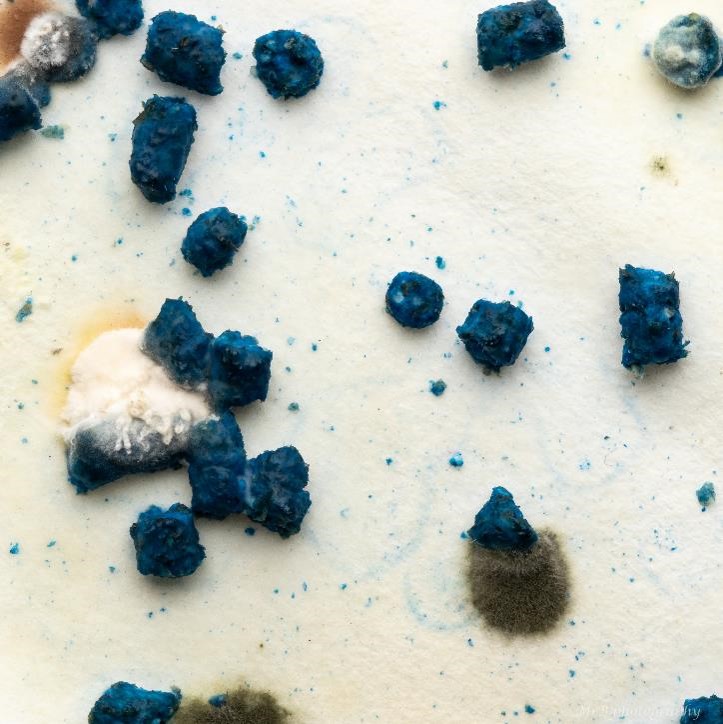
Product performance under dry and wet conditions
A very simple experiment clearly shows this
- Grow susceptible plants in a tray.
- Apply slug pellets. Keep dry or irrigate with 5mm of rain twice per day
- After 4 days introduce a known quantity of grey field slugs
- Assess plant damage 3-10 days after slugs have been introduced.

- Both of the products tested offer similar levels of protection under dry conditions.
- However under wet conditions, when slugs are most active, the Sluxx HP formulation shows significantly better levels of protection versus a leading ferric alternative.
Baiting points
Sluxx HP offers an excellent number of baiting points when compared to an alternative leading ferric phosphate pellet. This ensures that the slug will quickly come across the pellet during feeding activity and help protect the crop.


Calibration Wizard
Our new online Calibration Wizard can take the hassle out of setting up your spreader. Fine tune application rate and forward speed with ease.
Simple to use – select your pellet type, spreader, spread width and application rate. The calibration wizard will output recommendations for disc speed, feed rotor and aperture settings. Providing you with a choice of appropriate forward speeds.

Application
It is important to check the settings of your applicator when changing brand and pellet type.
Each brand may have different characteristics in terms of size and ballistic properties, which lead to potential variations and discrepancies if not adjusted when changing between pellet.
Further information and applicator testing can be found at
Setting Up Your Pelleter
Watch these handy videos from technical specialist Harry Raley, with top tips for setting up your pelleter and using the Calibration Wizard.
Slug Trapping
Slug monitoring is essential to understand what is happening at field level and slug traps can be used to monitor activity.
Guide to using slug traps:
- Ideally moist soil surface and mild weather (5C-25C)
- Trap covers ideally a plastic cover approx. 25 cm across. Remember to weigh down traps
- Use a grain based bait. E.g. layers mash (not slug pellets)
- 9 – 13 traps per field in ‘W’ pattern and known hot spots
- Leave overnight and examine early morning
- Continue to trap until crops have passed vulnerable stage
For wheat: a catch of 4 or more slugs per trap indicates a possible risk, where soil and weather conditions favour slug activity
For winter oilseed rape: weather conditions during the short period between harvesting cereals (especially wheat) and drilling may not suit trapping.
It may be worthwhile to trap in standing cereals up to 10 days before harvest, particularly if you plan to broadcast seeds into standing cereals or stubble (e.g. Autocast). In the 7-10 days before cereal harvest, or in stubble.
A catch of 4 or more slugs per trap in standing cereals, or 1 or more slugs/trap in cereal stubble indicates possible risk.
Potatoes and Field Vegetables: a count of 1 slug per trap indicates risk to the crop

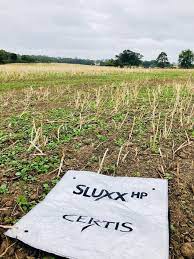
FIND OUT MORE ABOUT SLUXX HP
SLUG FACTS WITH DR GORDON PORT
Hear all the facts you need to know about slug behaviour from Dr Gordon Port. Including most common species in UK crops and their feeding habits.
WHAT MAKES A GOOD SLUG PELLET?
Dr Gordon Port explains the characteristics that make a good quality and effective slug pellet, based on years of in-depth slug research and understanding of slug behaviour.
WHAT MAKES SLUXX HP DIFFERENT?
Neil Beadle explains what makes Sluxx HP such an effective, high quality slug pellet
Certis UK regional technical specialist Geoffrey Bastard along with Professor Keith Walters of Harper Adams University explain how we investigated the behaviour of slugs once they have ingested ferric phosphate pellets.
03/08/2021
WET WEATHER SPARKS SLUG WARNING FOR EARLY OSR CROPS
Early drilled oilseed rape crops will be established over the next fortnight and growers are urged to be proactive in their defence against slug attack after recent rains heightened risk.
26/07/2021
APPLICATOR CALIBRATION KEY TO EARLY SEASON SLUG CONTROL
Appreciating the advantages of different sized slug pellets and using tools such as the Calibration Wizard when switching between these products will optimise slug control this autumn.

05/08/2020
NEW ONLINE TOOL AIDS MORE ACCURATE SLUG PELLET APPLICATION
A new online tool to help operators set up slug pellet applicators to accurately apply specific pellet products is now live.

12/08/2020
ORIGINAL FERRIC PHOSPHATE SLUG PELLET FORMULATION STILL FIRST…
With the future of metaldehyde still in doubt and its environmental credentials seen less favourably amongst growers and advisers, there is an increasing demand for ferric phosphate-based pellets for slug…

08/10/2019
SEED-BED QUALITY KEY TO REDUCE SLUG SEED HOLLOWING THIS AUTUM
In the first autumn without insecticide seed treatment Deter, growers should place added emphasis on seed-bed quality.

02/10/2019
WETTER SUMMER COULD ENCOURAGE SLUGS IN WINTER PLANTINGS
Last year dry, hot weather persisted throughout the summer, suppressing slug levels in winter crops. This August was quite a contrast, with warmer wetter conditions dampening soil and potentially increasing…
13/08/2019
9 TIPS TO MINIMISE SLUG DAMAGE IN ARABLE CROPS THIS AUTUM
The UK climate provides a perfect environment for slugs to thrive and most arable farmers have an annual battle with the pest. Certis arable product manager Neil Beadle offers some useful advice on how to win…

05/08/2019
CULTURE CONTROLS AND PRECISION TECH HELPS YORKSHIRE GROWER…
With chemical tools for managing slugs in arable crops being lost, there is more emphasis on cultural controls for reducing risk. We speak to a Yorkshire farmer who is combining good crop husbandry and…

18/06/2019
PELLET QUALITY A KEY FACTOR IN EFFECTIVE SLUG CONTROL
Growers are advised to choose good quality ferric phosphate pellets to maintain adequate slug control as the industry shifts from metaldehyde over the next 12 months.
17/10/2018
COVER CROPS TRIALS PROVIDE INSIGHT INTO SLUG ACTIVITY
Contrary to popular perception that cover crops can further increase slug pressure over the winter period leading to problems with spring crops, a recent trial undertaken by Natural England has shown otherwise.
24/09/2018
CERTIS LAUNCHES NEW SLUGWATCH APP
Certis is launching a new SlugWatch app this week to help agronomists and farmers assess slug pressure in their area.
02/09/2018
PROTECT YIELD AND PROFIT FROM DAY ONE
Understanding the weed, pest and disease risks from the point of establishment, is key to protecting ultimate profit, according to experts speaking ahead of this year’s CropTec event.
09/07/2018
When wet weather hits, slug populations can emerge to cause damage that can be devastating to cereal crop establishment. When used as part of an IPM approach, applying slug pellets can be an effective method…
19/07/2018
As slug populations lie in wait below ground following a dry spring, Geoffrey Bastard regional technical specialist at Certis, gives us his advice for getting ahead of the slimy army next season.
12/07/2018
NEW RESEARCH INTO FERRIC PHOSPHATE MODE OF ACTION
A recent Harper Adams University study will give growers a glimpse into the subterranean world to address common misconceptions of slug behaviour once ferric phosphate has been ingested.
02/09/2018
INVESTIGATION INTO THE EFFECTS OF FERRIC PHOSPHATE
Geoffrey Bastard, Regional Technical Specialist at Certis highlights the importance of understanding the difference in slug behaviour when using a ferric phosphate based pellet, such as Sluxx HP.
Check the SlugWatch forecast in your area. Or download the SlugWatch APP to measure slug pressure on the go.
The forecast allows you to view location-specific slug activity data, along with information on weather conditions, helping you to make informed decisions on slug monitoring and applying slug pellets.

